Ionizing radiation
Ionizing radiation(US,ionising radiationin the UK), includingnuclear radiation,consists ofsubatomic particlesorelectromagnetic wavesthat have sufficientenergytoionizeatomsormoleculesby detachingelectronsfrom them.[1]Some particles can travel up to 99% of thespeed of light,and the electromagnetic waves are on the high-energy portion of theelectromagnetic spectrum.
Gamma rays,X-rays,and the higher energyultravioletpart of the electromagnetic spectrum are ionizing radiation, whereas the lower energyultraviolet,visiblelight,nearly all types oflaserlight,infrared,microwaves,andradio wavesarenon-ionizing radiation.The boundary between ionizing and non-ionizing radiation in the ultraviolet area cannot be sharply defined, as different molecules and atoms ionize atdifferent energies.The energy of ionizing radiation starts between 10electronvolts(eV) and 33 eV.[citation needed]
Typical ionizing subatomic particles includeAlpha particles,beta particles,andneutrons.These are typically created byradioactive decay,and almost all are energetic enough to ionize. There are also secondarycosmic particlesproduced aftercosmic raysinteract with Earth's atmosphere, includingmuons,mesons,andpositrons.[2][3]Cosmic raysmay also produceradioisotopeson Earth (for example,carbon-14), which in turn decay and emit ionizing radiation. Cosmic rays and the decay of radioactiveisotopesare the primary sources of natural ionizing radiation on Earth, contributing tobackground radiation.Ionizing radiation is also generated artificially byX-ray tubes,particle accelerators,andnuclear fission.
Ionizing radiation is not immediately detectable by human senses, so instruments such asGeiger countersare used to detect and measure it. However, very high energy particles can produce visibleeffects on both organicand inorganic matter (e.g. water lighting inCherenkov radiation) or humans (e.g.acute radiation syndrome).[4]
Ionizing radiation is used in a wide variety of fields such asmedicine,nuclear power,research, and industrial manufacturing, but presents a health hazard if proper measures against excessive exposure are not taken. Exposure to ionizing radiation causes cell damage to livingtissueandorgan damage.In high acute doses, it will result inradiation burnsandradiation sickness,and lower level doses over a protracted time can causecancer.[5][6]TheInternational Commission on Radiological Protection(ICRP) issues guidance on ionizing radiation protection, and the effects of dose uptake on human health.
Directly ionizing radiation[edit]

He
) nucleus and isstoppedby a sheet of paper. Beta (β) radiation, consisting ofelectrons,is halted by an aluminium plate. Gamma (γ) radiation, consisting of energeticphotons,is eventually absorbed as it penetrates a dense material. Neutron (n) radiation consists of free neutrons that are blocked by light elements, like hydrogen, which slow and/or capture them. Not shown:galactic cosmic raysthat consist of energetic charged nuclei such asprotons,heliumnuclei, and high-charged nuclei calledHZE ions.
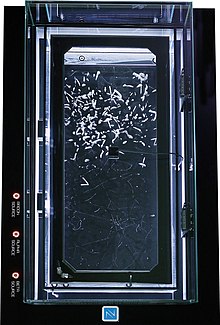
Ionizing radiation may be grouped as directly or indirectly ionizing.
Any charged particle with mass can ionizeatomsdirectly byfundamental interactionthrough theCoulomb forceif it carries sufficient kinetic energy. Such particles includeatomic nuclei,electrons,muons,chargedpions,protons,and energetic charged nuclei stripped of their electrons. When moving at relativistic speeds (near thespeed of light,c) these particles have enough kinetic energy to be ionizing, but there is considerable speed variation. For example, a typical Alpha particle moves at about 5% of c, but an electron with 33 eV (just enough to ionize) moves at about 1% of c.
Two of the first types of directly ionizing radiation to be discovered areAlpha particleswhich are helium nuclei ejected from the nucleus of an atom during radioactive decay, and energetic electrons, which are calledbeta particles.
Naturalcosmic raysare made up primarily of relativistic protons but also include heavier atomic nuclei likeheliumions andHZE ions.In the atmosphere such particles are often stopped by air molecules, and this produces short-lived charged pions, which soon decay to muons, a primary type of cosmic ray radiation that reaches the surface of the earth. Pions can also be produced in large amounts inparticle accelerators.
Alpha particles[edit]
Alpha particles consist of twoprotonsand twoneutronsbound together into a particle identical to aheliumnucleus.Alpha particle emissions are generally produced in the process ofAlpha decay.
Alpha particles are a strongly ionizing form of radiation, but when emitted by radioactive decay they have low penetration power and can beabsorbedby a few centimeters of air, or by the top layer of human skin. More powerful Alpha particles fromternary fissionare three times as energetic, and penetrate proportionately farther in air. The helium nuclei that form 10–12% of cosmic rays, are also usually of much higher energy than those produced by radioactive decay and pose shielding problems in space. However, this type of radiation is significantly absorbed by the Earth's atmosphere, which is a radiation shield equivalent to about 10 meters of water.[7]
The Alpha particle was named byErnest Rutherfordafter the first letter in theGreek Alpha bet,α,when he ranked the known radioactive emissions in descending order of ionising effect in 1899. The symbol is α or α2+.Because they are identical to helium nuclei, they are also sometimes written asHe2+
or4
2He2+
indicating a Helium ion with a +2 charge (missing its two electrons). If the ion gains electrons from its environment, the Alpha particle can be written as a normal (electrically neutral) helium atom4
2He.
Beta particles[edit]
Beta particles are high-energy, high-speedelectronsorpositronsemitted by certain types ofradioactivenuclei,such aspotassium-40.The production of beta particles is termedbeta decay.They are designated by theGreek letterbeta (β). There are two forms of beta decay, β−and β+,which respectively give rise to the electron and the positron.[8]Beta particles are much less penetrating than gamma radiation, but more penetrating than Alpha particles.
High-energy beta particles may produce X-rays known asbremsstrahlung( "braking radiation" ) orsecondary electrons(delta ray) as they pass through matter. Both of these can cause an indirect ionization effect. Bremsstrahlung is of concern when shielding beta emitters, as the interaction of beta particles with some shielding materials produces Bremsstrahlung. The effect is greater with material having high atomic numbers, so material with low atomic numbers is used for beta source shielding.
Positrons and other types of antimatter[edit]
The positron or antielectron is theantiparticleor theantimattercounterpart of theelectron.When a low-energy positron collides with a low-energy electron,annihilationoccurs, resulting in their conversion into the energy of two or moregamma rayphotons(seeelectron–positron annihilation). As positrons are positively charged particles they can directly ionize an atom through Coulomb interactions.
Positrons can be generated bypositron emissionnuclear decay (throughweak interactions), or bypair productionfrom a sufficiently energeticphoton.Positrons are common artificial sources of ionizing radiation used in medicalpositron emission tomography(PET) scans.
Charged nuclei[edit]
Charged nuclei are characteristic of galactic cosmic rays and solar particle events and except for Alpha particles (charged helium nuclei) have no natural sources on earth. In space, however, very high energy protons, helium nuclei, and HZE ions can be initially stopped by relatively thin layers of shielding, clothes, or skin. However, the resulting interaction will generate secondary radiation and cause cascading biological effects. If just one atom of tissue is displaced by an energetic proton, for example, the collision will cause further interactions in the body. This is called "linear energy transfer"(LET), which utilizeselastic scattering.
LET can be visualized as a billiard ball hitting another in the manner of theconservation of momentum,sending both away with the energy of the first ball divided between the two unequally. When a charged nucleus strikes a relatively slow-moving nucleus of an object in space, LET occurs and neutrons, Alpha particles, low-energy protons, and other nuclei will be released by the collisions and contribute to the total absorbed dose of tissue.[9]
Indirectly ionizing radiation[edit]
Indirectly ionizing radiation is electrically neutral and does not interact strongly with matter, therefore the bulk of the ionization effects are due to secondary ionization.
Photon radiation[edit]
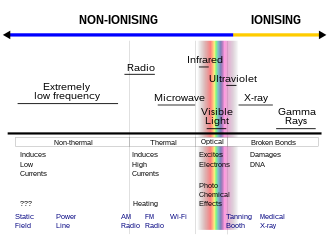
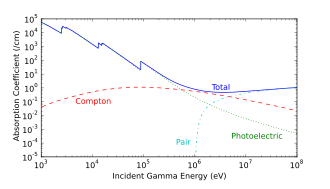
Even though photons are electrically neutral, they can ionizeatomsindirectly through thephotoelectric effectand theCompton effect.Either of those interactions will cause the ejection of an electron from an atom at relativistic speeds, turning that electron into a beta particle (secondary beta particle) that will ionize other atoms. Since most of the ionized atoms are due to thesecondary betaparticles, photons are indirectly ionizing radiation.[10]
Radiated photons are calledgamma raysif they are produced by anuclear reaction,subatomic particledecay, orradioactive decaywithin the nucleus. They are calledx-raysif produced outside the nucleus. The generic term "photon" is used to describe both.[11][12][13]
X-rays normally have a lower energy than gamma rays, and an older convention was to define the boundary as a wavelength of 10−11m (or a photon energy of 100 keV).[14]That threshold was driven by historic limitations of older X-ray tubes and low awareness ofisomeric transitions.Modern technologies and discoveries have shown an overlap between X-ray and gamma energies. In many fields they are functionally identical, differing for terrestrial studies only in origin of the radiation. In astronomy, however, where radiation origin often cannot be reliably determined, the old energy division has been preserved, with X-rays defined as being between about 120 eV and 120 keV, and gamma rays as being of any energy above 100 to 120 keV, regardless of source. Most astronomical "gamma-ray astronomy"are knownnotto originate in nuclear radioactive processes but, rather, result from processes like those that produce astronomical X-rays, except driven by much more energetic electrons.
Photoelectric absorption is the dominant mechanism in organic materials for photon energies below 100 keV, typical of classical X-ray tube originatedX-rays.At energies beyond 100 keV, photons ionize matter increasingly through theCompton effect,and then indirectly throughpair productionat energies beyond 5 MeV. The accompanying interaction diagram shows two Compton scatterings happening sequentially. In every scattering event, the gamma ray transfers energy to an electron, and it continues on its path in a different direction and with reduced energy.
Definition boundary for lower-energy photons[edit]
The lowest ionization energy of any element is 3.89 eV, forcaesium.However, US Federal Communications Commission material defines ionizing radiation as that with aphoton energygreater than 10 eV (equivalent to a farultravioletwavelength of 124nanometers).[15]Roughly, this corresponds to both the firstionization energyof oxygen, and the ionization energy of hydrogen, both about 14 eV.[16]In someEnvironmental Protection Agencyreferences, the ionization of a typical water molecule at an energy of 33 eV is referenced[17]as the appropriate biological threshold for ionizing radiation: this value represents the so-calledW-value,the colloquial name for theICRU'smean energy expended in a gas per ion pair formed,[18]which combines ionization energy plus the energy lost to other processes such asexcitation.[19]At 38 nanometers wavelength forelectromagnetic radiation,33 eV is close to the energy at the conventional 10 nm wavelength transition between extreme ultraviolet and X-ray radiation, which occurs at about 125 eV. Thus, X-ray radiation is always ionizing, but only extreme-ultraviolet radiation can be considered ionizing under all definitions.
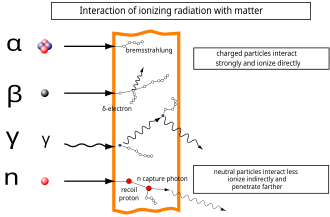
Neutrons[edit]
This sectionneeds additional citations forverification.(May 2024) |
Neutronshave a neutral electrical charge often misunderstood as zero electrical charge and thus often do notdirectlycause ionization in a single step or interaction with matter. However, fast neutrons will interact with the protons in hydrogen vialinear energy transfer,energy that a particle transfers to the material it is moving through. This mechanism scatters the nuclei of the materials in the target area, causing direct ionization of the hydrogen atoms. When neutrons strike the hydrogen nuclei, proton radiation (fast protons) results. These protons are themselves ionizing because they are of high energy, are charged, and interact with the electrons in matter.
Neutrons that strike other nuclei besides hydrogen will transfer less energy to the other particle if linear energy transfer does occur. But, for many nuclei struck by neutrons,inelastic scatteringoccurs. Whether elastic or inelastic scatter occurs is dependent on the speed of the neutron, whetherfastorthermalor somewhere in between. It is also dependent on the nuclei it strikes and itsneutron cross section.
In inelastic scattering, neutrons are readily absorbed in a type ofnuclear reactioncalledneutron captureand attributes to theneutron activationof the nucleus. Neutron interactions with most types of matter in this manner usually produceradioactivenuclei. The abundantoxygen-16nucleus, for example, undergoes neutron activation, rapidly decays by a proton emission formingnitrogen-16,which decays to oxygen-16. The short-lived nitrogen-16 decay emits a powerful beta ray. This process can be written as:
16O (n,p)16N (fast neutron capture possible with >11 MeV neutron)
16N →16O + β−(Decay t1/2= 7.13 s)
This high-energy β−further interacts rapidly with other nuclei, emitting high-energy γ viaBremsstrahlung
While not a favorable reaction, the16O (n,p)16N reaction is a major source of X-rays emitted from the cooling water of apressurized water reactorand contributes enormously to the radiation generated by a water-coolednuclear reactorwhile operating.
For the best shielding of neutrons, hydrocarbons that have an abundance ofhydrogenare used.
Infissilematerials, secondary neutrons may producenuclear chain reactions,causing a larger amount of ionization from thedaughter productsof fission.
Outside the nucleus, free neutrons are unstable and have a mean lifetime of 14 minutes, 42 seconds. Free neutrons decay by emission of an electron and an electron antineutrino to become a proton, a process known asbeta decay:[20]
In the adjacent diagram, a neutron collides with a proton of the target material, and then becomes a fast recoil proton that ionizes in turn. At the end of its path, the neutron is captured by a nucleus in an (n,γ)-reaction that leads to the emission of aneutron capturephoton. Such photons always have enough energy to qualify as ionizing radiation.
Physical effects[edit]
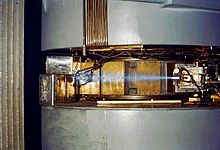
Nuclear effects[edit]
Neutron radiation, Alpha radiation, and extremely energetic gamma (> ~20 MeV) can causenuclear transmutationandinduced radioactivity.The relevant mechanisms areneutron activation,Alpha absorption,andphotodisintegration.A large enough number of transmutations can change macroscopic properties and cause targets to become radioactive themselves, even after the original source is removed.
Chemical effects[edit]
Ionization of molecules can lead toradiolysis(breaking chemical bonds), and formation of highly reactivefree radicals.These free radicals may then react chemically with neighbouring materials even after the original radiation has stopped. (e.g.,ozone crackingof polymers by ozone formed by ionization of air). Ionizing radiation can also accelerate existing chemical reactions such as polymerization and corrosion, by contributing to the activation energy required for the reaction. Optical materials deteriorate under the effect of ionizing radiation.
High-intensity ionizing radiation in air can produce a visibleionized air glowof telltale bluish-purple color. The glow can be observed, e.g., duringcriticality accidents,aroundmushroom cloudsshortly after anuclear explosion,or the inside of a damaged nuclear reactor like during theChernobyl disaster.
Monatomic fluids, e.g. moltensodium,have no chemical bonds to break and no crystal lattice to disturb, so they are immune to the chemical effects of ionizing radiation. Simple diatomic compounds with very negativeenthalpy of formation,such ashydrogen fluoridewill reform rapidly and spontaneously after ionization.
Electrical effects[edit]
The ionization of materials temporarily increases their conductivity, potentially permitting damaging current levels. This is a particular hazard insemiconductormicroelectronics employed in electronic equipment, with subsequent currents introducing operation errors or even permanently damaging the devices. Devices intended for high radiation environments such as the nuclear industry and extra-atmospheric (space) applications may be maderadiation hardto resist such effects through design, material selection, and fabrication methods.
Proton radiation found in space can also causesingle-event upsetsin digital circuits. The electrical effects of ionizing radiation are exploited in gas-filled radiation detectors, e.g. theGeiger-Muller counteror theion chamber.
Health effects[edit]
Most adverse health effects of exposure to ionizing radiation may be grouped in two general categories:
- deterministic effects (harmful tissue reactions) due in large part to killing or malfunction of cells following high doses fromradiation burns.
- stochastic effects, i.e.,cancerand heritable effects involving either cancer development in exposed individuals owing tomutationof somatic cells or heritable disease in their offspring owing to mutation of reproductive (germ) cells.[21]
The most common impact is stochasticinduction of cancerwith a latent period of years or decades after exposure. For example, ionizing radiation is one cause ofchronic myelogenous leukemia,[22][23][24]although most people with CML have not been exposed to radiation.[23][24]The mechanism by which this occurs is well understood, but quantitative models predicting the level of risk remain controversial.[citation needed]
The most widely accepted model, theLinear no-threshold model(LNT), holds that the incidence of cancers due to ionizing radiation increases linearly witheffective radiation doseat a rate of 5.5% persievert.[25]If this is correct, then naturalbackground radiationis the most hazardous source of radiation to general public health, followed by medical imaging as a close second. Other stochastic effects of ionizing radiation areteratogenesis,cognitive decline,andheart disease.[citation needed]
AlthoughDNAis always susceptible to damage by ionizing radiation, the DNA molecule may also be damaged by radiation with enough energy to excite certainmolecular bondsto formpyrimidine dimers.This energy may be less than ionizing, but near to it. A good example is ultraviolet spectrum energy which begins at about 3.1 eV (400 nm) at close to the same energy level which can causesunburnto unprotected skin, as a result ofphotoreactionsincollagenand (in theUV-Brange) also damage in DNA (for example, pyrimidine dimers). Thus, the mid and lower ultraviolet electromagnetic spectrum is damaging to biological tissues as a result of electronic excitation in molecules which falls short of ionization, but produces similar non-thermal effects. To some extent, visible light and also ultraviolet A (UVA) which is closest to visible energies, have been proven to result in formation ofreactive oxygen speciesin skin, which cause indirect damage since these are electronically excited molecules which can inflict reactive damage, although they do not cause sunburn (erythema).[26]Like ionization-damage, all these effects in skin are beyond those produced by simple thermal effects.[citation needed]
Measurement of radiation[edit]
The table below shows radiation and dose quantities in SI and non-SI units.
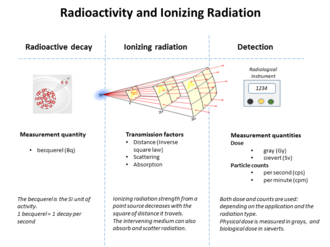
| Quantity | Detector | CGS units | SI units | Other units |
|---|---|---|---|---|
| Disintegration rate | curie | becquerel | ||
| Particleflux | Geiger counter,proportional counter,scintillator | counts/cm2· second | counts/metre2· second | counts per minute,particles per cm2per second |
| Energyfluence | thermoluminescent dosimeter,film badge dosimeter | MeV/cm2 | joule/metre2 | |
| Beam energy | proportional counter | electronvolt | joule | |
| Linear energy transfer | derived quantity | MeV/cm | Joule/metre | keV/μm |
| Kerma | ionization chamber,semiconductor detector,quartz fiber dosimeter,Kearny fallout meter | esu/cm3 | gray(joule/kg) | roentgen |
| Absorbed dose | calorimeter | rad | gray | rep |
| Equivalent dose | derived quantity | rem | sievert(joule/kg×WR) | |
| Effective dose | derived quantity | rem | sievert(joule/kg×WR×WT) | BRET |
| Committed dose | derived quantity | rem | sievert | banana equivalent dose |
Uses of radiation[edit]
Ionizing radiation has many industrial, military, and medical uses. Its usefulness must be balanced with its hazards, a compromise that has shifted over time. For example, at one time, assistants in shoe shops in the USused X-rays to check a child's shoe size,but this practice was halted when the risks of ionizing radiation were better understood.[27]
Neutron radiation is essential to the working ofnuclear reactorsandnuclear weapons.The penetrating power of x-ray, gamma, beta, and positron radiation is used formedical imaging,nondestructive testing,and a variety of industrial gauges.Radioactive tracersare used in medical and industrial applications, as well as biological andradiation chemistry.Alpha radiation is used instatic eliminatorsandsmoke detectors.The sterilizing effects of ionizing radiation are useful for cleaning medical instruments,food irradiation,and thesterile insect technique.Measurements ofcarbon-14,can be used todatethe remains of long-dead organisms (such as wood that is thousands of years old).
Sources of radiation[edit]
Ionizing radiation is generated through nuclear reactions, nuclear decay, by very high temperature, or via acceleration of charged particles in electromagnetic fields. Natural sources include the sun, lightning and supernova explosions. Artificial sources include nuclear reactors, particle accelerators, andx-ray tubes.
TheUnited Nations Scientific Committee on the Effects of Atomic Radiation(UNSCEAR) itemized types of human exposures.
| Public exposure | ||
| Natural Sources | Normal occurrences | Cosmic radiation |
| Terrestrial radiation | ||
| Enhanced sources | Metal miningandsmelting | |
| Phosphateindustry | ||
| Coal miningand power production from coal | ||
| Oiland gas drilling | ||
| Rare earthandtitanium dioxideindustries | ||
| Zirconiumandceramicsindustries | ||
| Application ofradiumandthorium | ||
| Other exposure situations | ||
| Human-made sources | Peaceful purposes | Nuclear powerproduction |
| Transport of nuclear and radioactive material | ||
| Application other than nuclear power | ||
| Military purposes | Nuclear tests | |
| Residues in the environment.Nuclear fallout | ||
| Historical situations | ||
| Exposure from accidents | ||
| Occupational radiation exposure | ||
| Natural Sources | Cosmic ray exposures ofaircrewandspace crew | |
| Exposures in extractive and processing industries | ||
| Gas and oil extraction industries | ||
| Radon exposure in workplaces other than mines | ||
| Human-made sources | Peaceful purposes | Nuclear power industries |
| Medical uses of radiation | ||
| Industrial uses of radiation | ||
| Miscellaneous uses | ||
| Military purposes | Other exposed workers | |
| SourceUNSCEAR 2008 Annex Bretrieved 2011-7-4 | ||
TheInternational Commission on Radiological Protectionmanages the International System of Radiological Protection, which sets recommended limits for dose uptake.
Background radiation[edit]
Background radiation comes from both natural and human-made sources.
The global average exposure of humans to ionizing radiation is about 3 mSv (0.3 rem) per year, 80% of which comes from nature. The remaining 20% results from exposure to human-made radiation sources, primarily frommedical imaging.Average human-made exposure is much higher in developed countries, mostly due toCT scansandnuclear medicine.
Naturalbackground radiationcomes from five primary sources: cosmic radiation, solar radiation, external terrestrial sources, radiation in the human body, andradon.
The background rate for natural radiation varies considerably with location, being as low as 1.5 mSv/a (1.5 mSv per year) in some areas and over 100 mSv/a in others. The highest level of purely natural radiation recorded on the Earth's surface is 90 μGy/h (0.8 Gy/a) on a Brazilian black beach composed ofmonazite.[28]The highest background radiation in an inhabited area is found inRamsar,primarily due to naturally radioactive limestone used as a building material. Some 2000 of the most exposed residents receive an averageradiation doseof 10mGyper year, (1rad/yr) ten times more than the ICRP recommended limit for exposure to the public from artificial sources.[29]Record levels were found in a house where theeffective radiation dosedue to external radiation was 135 mSv/a, (13.5 rem/yr) and thecommitted dosefromradonwas 640 mSv/a (64.0 rem/yr).[30]This unique case is over 200 times higher than the world average background radiation. Despite the high levels of background radiation that the residents of Ramsar receive there is no compelling evidence that they experience a greater health risk. The ICRP recommendations are conservative limits and may represent an over representation of the actual health risk. Generally radiation safety organization recommend the most conservative limits assuming it is best to err on the side of caution. This level of caution is appropriate but should not be used to create fear about background radiation danger. Radiation danger from background radiation may be a serious threat but is more likely a small overall risk compared to all other factors in the environment.
Cosmic radiation[edit]
The Earth, and all living things on it, are constantly bombarded by radiation from outside our solar system. This cosmic radiation consists of relativistic particles: positively charged nuclei (ions) from 1amuprotons(about 85% of it) to 26 amuironnucleiand even beyond. (The high-atomic number particles are calledHZE ions.) The energy of this radiation can far exceed that which humans can create, even in the largestparticle accelerators(seeultra-high-energy cosmic ray). This radiation interacts in the atmosphere to create secondary radiation that rains down, includingx-rays,muons,protons,antiprotons,Alpha particles,pions,electrons,positrons,andneutrons.
Thedosefrom cosmic radiation is largely from muons, neutrons, and electrons, with a dose rate that varies in different parts of the world and based largely on the geomagnetic field, altitude, and solar cycle. The cosmic-radiation dose rate on airplanes is so high that, according to the United Nations UNSCEAR 2000 Report (see links at bottom), airline flight crew workers receive more dose on average than any other worker, including those in nuclear power plants. Airline crews receive more cosmic rays if they routinely work flight routes that take them close to the North or South pole at high altitudes, where this type of radiation is maximal.
Cosmic rays also include high-energy gamma rays, which are far beyond the energies produced by solar or human sources.
External terrestrial sources[edit]
Most materials on Earth contain some radioactiveatoms,even if in small quantities. Most of the dose received from these sources is from gamma-ray emitters in building materials, or rocks and soil when outside. The majorradionuclidesof concern forterrestrial radiationare isotopes ofpotassium,uranium,andthorium.Each of these sources has been decreasing in activity since the formation of the Earth.
Internal radiation sources[edit]
All earthly materials that are the building blocks of life contain a radioactive component. As humans, plants, and animals consume food, air, and water, an inventory of radioisotopes builds up within the organism (seebanana equivalent dose). Some radionuclides, likepotassium-40,emit a high-energy gamma ray that can be measured by sensitive electronic radiation measurement systems. These internal radiation sources contribute to an individual's total radiation dose fromnatural background radiation.
Radon[edit]
An important source of natural radiation isradongas, which seeps continuously from bedrock but can, because of its high density, accumulate in poorly ventilated houses.
Radon-222is a gas produced by the α-decay ofradium-226. Both are a part of the naturaluraniumdecay chain. Uranium is found in soil throughout the world in varying concentrations. Radon is the largest cause of lung cancer among non-smokers and the second-leading cause overall.[31]
Radiation exposure[edit]
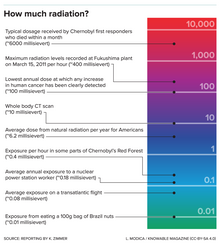


There are three standard ways to limit exposure:
- Time:For people exposed to radiation in addition to natural background radiation, limiting or minimizing the exposure time will reduce the dose from the source of radiation.
- Distance:Radiation intensity decreases sharply with distance, according to aninverse-square law(in an absolute vacuum).[32]
- Shielding:Air or skin can be sufficient to substantially attenuate Alpha radiation, while sheet metal or plastic is often sufficient to stop beta radiation. Barriers oflead,concrete,or water are often used to give effective protection from more penetrating forms of ionizing radiation such as gamma rays andneutrons.Some radioactive materials are stored or handled underwater or byremote controlin rooms constructed of thick concrete or lined with lead. There are specialplasticshields that stop beta particles, and air will stop most Alpha particles. The effectiveness of a material in shielding radiation is determined by itshalf-value thicknesses,the thickness of material that reduces the radiation by half. This value is a function of the material itself and of the type and energy of ionizing radiation. Some generally accepted thicknesses of attenuating material are 5 mm of aluminum for most beta particles, and 3 inches of lead for gamma radiation.
These can all be applied to natural and human-made sources. For human-made sources the use ofContainmentis a major tool in reducing dose uptake and is effectively a combination of shielding and isolation from the open environment. Radioactive materials are confined in the smallest possible space and kept out of the environment such as in ahot cell(for radiation) orglove box(for contamination).Radioactive isotopesfor medical use, for example, are dispensed in closed handling facilities, usually gloveboxes, whilenuclear reactorsoperate within closed systems with multiple barriers that keep the radioactive materials contained. Work rooms, hot cells and gloveboxes have slightly reduced air pressures to prevent escape of airborne material to the open environment.
In nuclear conflicts or civil nuclear releasescivil defensemeasures can help reduce exposure of populations by reducing ingestion of isotopes and occupational exposure. One is the issue ofpotassium iodide(KI) tablets, which blocks the uptake ofradioactive iodine(one of the major radioisotope products ofnuclear fission) into the humanthyroidgland.
Occupational exposure[edit]
Occupationally exposed individuals are controlled within the regulatory framework of the country they work in, and in accordance with any local nuclear licence constraints. These are usually based on the recommendations of theInternational Commission on Radiological Protection. The ICRP recommends limiting artificial irradiation. For occupational exposure, the limit is 50 mSv in a single year with a maximum of 100 mSv in a consecutive five-year period.[25]
The radiation exposure of these individuals is carefully monitored with the use ofdosimetersand other radiological protection instruments which will measure radioactive particulate concentrations, area gamma dose readings andradioactive contamination.A legal record of dose is kept.
Examples of activities where occupational exposure is a concern include:
- Airline crew (the most exposed population)
- Industrial radiography
- Medicalradiologyandnuclear medicine[33][34]
- Uranium mining
- Nuclear power plantandnuclear fuel reprocessing plantworkers
- Research laboratories (government, university and private)
Some human-made radiation sources affect the body through direct radiation, known aseffective dose (radiation)while others take the form ofradioactive contaminationandirradiatethe body from within. The latter is known ascommitted dose.
Public exposure[edit]
Medical procedures, such as diagnosticX-rays,nuclear medicine,andradiation therapyare by far the most significant source of human-made radiation exposure to the general public. Some of the majorradionuclidesused areI-131,Tc-99m,Co-60,Ir-192,andCs-137.The public is also exposed to radiation from consumer products, such astobacco(polonium-210), combustible fuels (gas,coal,etc.),televisions,luminouswatchesand dials (tritium), airportX-raysystems,smoke detectors(americium), electron tubes, and gas lantern mantles (thorium).
Of lesser magnitude, members of the public are exposed to radiation from thenuclear fuelcycle, which includes the entire sequence from processinguraniumto the disposal of the spent fuel. The effects of such exposure have not been reliably measured due to the extremely low doses involved. Opponents use a cancer per dose model to assert that such activities cause several hundred cases of cancer per year, an application of the widely acceptedLinear no-threshold model(LNT).
The International Commission on Radiological Protection recommends limiting artificial irradiation to the public to an average of 1 mSv (0.001 Sv) of effective dose per year, not including medical and occupational exposures.[25]
In anuclear war,gamma rays from both the initial weapon explosion andfalloutwould be the sources of radiation exposure.
Spaceflight[edit]
Massive particles are a concern for astronauts outside theEarth's magnetic fieldwho would receive solar particles fromsolar proton events(SPE) andgalactic cosmic raysfrom cosmic sources. These high-energy charged nuclei are blocked by Earth's magnetic field but pose amajor health concernfor astronauts traveling to the Moon and to any distant location beyond the Earth orbit. Highly charged HZE ions in particular are known to be extremely damaging, although protons make up the vast majority of galactic cosmic rays. Evidence indicates past SPE radiation levels that would have been lethal for unprotected astronauts.[35]
Air travel[edit]
Air travel exposes people on aircraft to increased radiation from space as compared to sea level, includingcosmic raysand fromsolar flareevents.[36][37]Software programs such asEpcard,CARI, SIEVERT, PCAIRE are attempts to simulate exposure by aircrews and passengers.[37]An example of a measured dose (not simulated dose) is 6 μSv per hour from London Heathrow to Tokyo Narita on a high-latitude polar route.[37]However, dosages can vary, such as during periods of high solar activity.[37]The United States FAA requires airlines to provide flight crew with information about cosmic radiation, and anInternational Commission on Radiological Protectionrecommendation for the general public is no more than 1 mSv per year.[37]In addition, many airlines do not allowpregnantflightcrew members, to comply with a European Directive.[37]The FAA has a recommended limit of 1 mSv total for a pregnancy, and no more than 0.5 mSv per month.[37]Information originally based onFundamentals of Aerospace Medicinepublished in 2008.[37]
Radiation hazard warning signs[edit]
Hazardous levels of ionizing radiation are signified by the trefoil sign on a yellow background. These are usually posted at the boundary of a radiation controlled area or in any place where radiation levels are significantly above background due to human intervention.
The red ionizing radiation warning symbol (ISO 21482) was launched in 2007, and is intended forIAEACategory 1, 2 and 3 sources defined as dangerous sources capable of death or serious injury, including food irradiators, teletherapy machines for cancer treatment and industrial radiography units. The symbol is to be placed on the device housing the source, as a warning not to dismantle the device or to get any closer. It will not be visible under normal use, only if someone attempts to disassemble the device. The symbol will not be located on building access doors, transportation packages or containers.[38]
-
Ionizing radiationhazard symbol
-
2007 ISOradioactivitydanger symbol intended forIAEACategory 1, 2 and 3 sources defined as dangerous sources capable of death or serious injury.[38]
See also[edit]
- European Committee on Radiation Risk
- International Commission on Radiological Protection– manages the International System of Radiological Protection
- Ionometer
- Irradiated mail
- National Council on Radiation Protection and Measurements– US national organisation
- Nuclear safety
- Nuclear semiotics
- Radiant energy
- Exposure (radiation)
- Radiation hormesis
- Radiation physics
- Radiation protection
- Radiation Protection Convention, 1960
- Radiation protection of patients
- Sievert
- Treatment of infections after accidental or hostile exposure to ionizing radiation
References[edit]
- ^"Ionizing radiation, health effects and protective measures".World Health Organization.29 April 2016.Archivedfrom the original on 29 March 2020.Retrieved22 January2020.
- ^Woodside, Gayle (1997).Environmental, Safety, and Health Engineering.US: John Wiley & Sons. p. 476.ISBN978-0471109327.Archivedfrom the original on 2015-10-19.
- ^Stallcup, James G. (2006).OSHA: Stallcup's High-voltage Telecommunications Regulations Simplified.US: Jones & Bartlett Learning. p. 133.ISBN978-0763743475.Archivedfrom the original on 2015-10-17.
- ^"Ionizing Radiation - Health Effects | Occupational Safety and Health Administration".osha.gov.Retrieved2022-06-23.
- ^Ryan, Julie (5 January 2012)."Ionizing Radiation: The Good, the Bad, and the Ugly".The Journal of Investigative Dermatology.132(3 0 2): 985–993.doi:10.1038/jid.2011.411.PMC3779131.PMID22217743.
- ^Herrera Ortiz AF, Fernández Beaujon LJ, García Villamizar SY, Fonseca López FF. Magnetic resonance versus computed tomography for the detection of retroperitoneal lymph node metastasis due to testicular cancer: A systematic literature review. European Journal of Radiology Open.2021;8:100372.https://doi.org/10.1016/j.ejro.2021.100372
- ^One kg of water per cm squared is 10 meters of waterArchived2016-01-01 at theWayback Machine
- ^"Beta Decay".Lbl.gov.9 August 2000. Archived fromthe originalon 3 March 2016.Retrieved10 April2014.
- ^Contribution of High Charge and Energy (HZE) Ions During Solar-Particle Event of September 29, 1989Kim, Myung-Hee Y.; Wilson, John W.; Cucinotta, Francis A.; Simonsen, Lisa C.; Atwell, William; Badavi, Francis F.; Miller, Jack, NASA Johnson Space Center; Langley Research Center, May 1999.
- ^European Centre of Technological Safety."Interaction of Radiation with Matter"(PDF).Radiation Hazard.Archived fromthe original(PDF)on 12 May 2013.Retrieved5 November2012.
- ^Feynman, Richard; Robert Leighton; Matthew Sands (1963).The Feynman Lectures on Physics, Vol.1.USA: Addison-Wesley. pp.2–5.ISBN978-0-201-02116-5.
- ^L'Annunziata, Michael; Mohammad Baradei (2003).Handbook of Radioactivity Analysis.Academic Press. p. 58.ISBN978-0-12-436603-9.Archivedfrom the original on 2021-04-16.Retrieved2020-10-26.
- ^Grupen, Claus; G. Cowan; S. D. Eidelman; T. Stroh (2005).Astroparticle Physics.Springer. p. 109.ISBN978-3-540-25312-9.
- ^Charles Hodgman, Ed. (1961).CRC Handbook of Chemistry and Physics, 44th Ed.USA: Chemical Rubber Co. p. 2850.
- ^Robert F. Cleveland, Jr.; Jerry L. Ulcek (August 1999)."Questions and Answers about Biological Effects and Potential Hazards of Radiofrequency Electromagnetic Fields"(PDF)(4th ed.). Washington, D.C.: OET (Office of Engineering and Technology) Federal Communications Commission.Archived(PDF)from the original on 2011-10-20.Retrieved2011-12-07.
- ^Jim Clark (2000)."Ionisation Energy".Archivedfrom the original on 2011-11-26.Retrieved2011-12-07.
- ^"Ionizing & Non-Ionizing Radiation".Radiation Protection.EPA. 2014-07-16. Archived fromthe originalon 2015-02-12.Retrieved2015-01-09.
- ^"Fundamental Quantities and Units for Ionizing Radiation (ICRU Report 85)".Journal of the ICRU.11(1). 2011.Archivedfrom the original on 2012-04-20.
- ^Hao Peng."Gas Filled Detectors"(PDF).Lecture notes for MED PHYS 4R06/6R03 – Radiation & Radioisotope Methodology.MacMaster University, Department of Medical Physics and Radiation Sciences. Archived fromthe original(PDF)on 2012-06-17.
- ^W.-M. Yao; et al. (2007)."Particle Data Group Summary Data Table on Baryons"(PDF).J. Phys. G.33(1). Archived fromthe original(PDF)on 2011-09-10.Retrieved2012-08-16.
- ^ICRP 2007,paragraph 55.
- ^Huether, Sue E.; McCance, Kathryn L. (2016-01-22).Understanding pathophysiology(6th ed.). St. Louis, Missouri: Elsevier. p. 530.ISBN9780323354097.OCLC740632205.
- ^ab"Chronic myeloid leukemia (CML)".Leukemia & Lymphoma Society.2015-02-26.Archivedfrom the original on 2019-09-22.Retrieved22 September2019.
- ^ab"Chronic myelogenous leukemia (CML) Chronic myelogenous leukemia (CML)".Medline PlusMedical Encyclopedia.U.S. National Library of Medicine.Archivedfrom the original on 29 September 2019.Retrieved22 September2019.
- ^abcICRP 2007.
- ^Liebel F, Kaur S, Ruvolo E, Kollias N, Southall MD (2012)."Irradiation of skin with visible light induces reactive oxygen species and matrix-degrading enzymes".J. Invest. Dermatol.132(7): 1901–1907.doi:10.1038/jid.2011.476.PMID22318388.
- ^Lewis, Leon; Caplan, Paul E (January 1, 1950)."The Shoe-fitting Fluoroscope as a Radiation Hazard".California Medicine.72(1): 26–30 [27].PMC1520288.PMID15408494.
- ^United Nations Scientific Committee on the Effects of Atomic Radiation(2000)."Annex B".Sources and Effects of Ionizing Radiation.Vol. 1. United Nations. p. 121. Archived fromthe originalon 4 August 2012.Retrieved11 November2012.
- ^Mortazavi, S.M.J.; P.A. Karamb (2005). "Apparent lack of radiation susceptibility among residents of the high background radiation area in Ramsar, Iran: can we relax our standards?".Radioactivity in the Environment.7:1141–1147.doi:10.1016/S1569-4860(04)07140-2.ISBN9780080441375.ISSN1569-4860.
- ^Sohrabi, Mehdi; Babapouran, Mozhgan (2005). "New public dose assessment from internal and external exposures in low- and elevated-level natural radiation areas of Ramsar, Iran".International Congress Series.1276:169–174.doi:10.1016/j.ics.2004.11.102.
- ^"Health Risks".Radon.EPA. Archived fromthe originalon 2008-10-20.Retrieved2012-03-05.
- ^Camphausen KA, Lawrence RC."Principles of Radiation Therapy"Archived2009-05-15 at theWayback Machinein Pazdur R, Wagman LD, Camphausen KA, Hoskins WJ (Eds)Cancer Management: A Multidisciplinary ApproachArchived2013-10-04 at theWayback Machine.11 ed. 2008.
- ^Pattison JE, Bachmann DJ, Beddoe AH (1996). "Gamma Dosimetry at Surfaces of Cylindrical Containers".Journal of Radiological Protection.16(4): 249–261.Bibcode:1996JRP....16..249P.doi:10.1088/0952-4746/16/4/004.S2CID71757795.
- ^Pattison, J.E. (1999). "Finger Doses Received during Samarium-153 Injections".Health Physics.77(5): 530–5.doi:10.1097/00004032-199911000-00006.PMID10524506.
- ^"Superflares could kill unprotected astronauts".New Scientist. 21 March 2005.Archivedfrom the original on 27 March 2015.
- ^"Effective Dose Rate".NAIRAS (Nowcast of Atmospheric Ionizing Radiation System).Archivedfrom the original on 2016-03-05.
- ^abcdefghJeffrey R. Davis; Robert Johnson; Jan Stepanek (2008).Fundamentals of Aerospace Medicine.Lippincott Williams & Wilkins. pp. 221–230.ISBN9780781774666.Archivedfrom the original on 2020-08-03.Retrieved2015-06-27– via Google Books.
- ^ab"New Symbol Launched to Warn Public About Radiation Dangers".International Atomic Energy Agency. February 15, 2007.Archivedfrom the original on 2007-02-17.
Literature[edit]
- ICRP (2007).The 2007 Recommendations of the International Commission on Radiological Protection (Annals of the ICRP).ICRP publication 103. Vol. 37:2–4.ISBN978-0-7020-3048-2.Archived fromthe originalon 16 November 2012.Retrieved17 May2012.
External links[edit]
- The Nuclear Regulatory Commissionregulates most commercial radiation sources and non-medical exposures in the US:
- NLM Hazardous Substances Databank – Ionizing Radiation
- United Nations Scientific Committee on the Effects of Atomic Radiation2000 ReportVolume 1: Sources,Volume 2: Effects
- Beginners Guide to Ionising Radiation Measurement
- Mike Hanley."XrayRisk: Radiation Risk Calculator. Calculate Radiation Dose and Cancer Risk".(from CT scans and xrays).
- Free Radiation Safety CourseArchived2018-04-16 at theWayback Machine
- Health Physics Society Public Education Website
- Oak Ridge ReservationBasic Radiation Facts

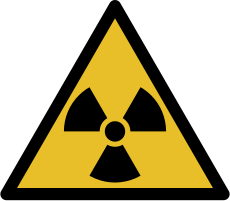
![2007 ISO radioactivity danger symbol intended for IAEA Category 1, 2 and 3 sources defined as dangerous sources capable of death or serious injury.[38]](https://upload.wikimedia.org/wikipedia/commons/thumb/3/35/Logo_iso_radiation.svg/242px-Logo_iso_radiation.svg.png)